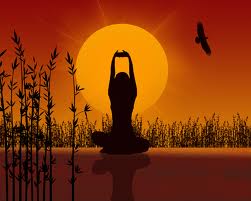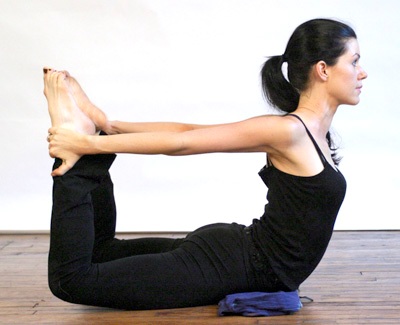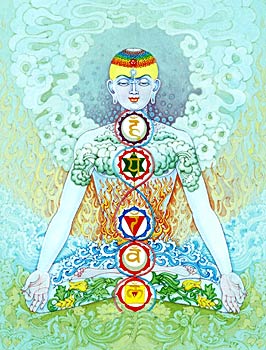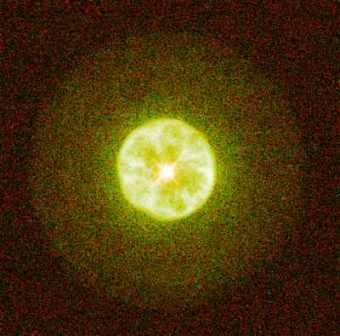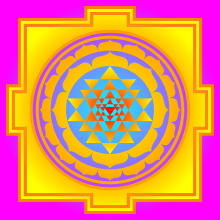Integral Health
The metaphysical basis for Integral Health — Yoga and health
Why do we need a distinct paradigm of health based on Integral Yoga? Before reflecting on this question, we have to consider a basic postulate, why do we need a yoga perspective of health at all? Sri Aurobindo describes yoga as “a methodised effort towards self-perfection” that proceeds along two dimensions:
(a) “the expression of the potentialities latent in the being”; and
(b) “a union of the human individual with the universal and transcendent Existence we see partially expressed in man and in the Cosmos (1).”
We shall attempt to understand the two dimensions of yoga in relation to health and well-being.
Expression of latent potentialities
The expression of latent possibilities is a fundamental yogic contribution and has gained world-wide acceptance. Different yogic processes work at different planes of consciousness and some of them have entered the annals of health and well-being. Through centuries of practice, different yogic perspectives have emerged, perfecting physical, cognitive and volitional techniques to their utmost perfection and precision. Thus the remarkable yoga-āsanas (yogic postures) of Haṭhayoga, which works at the level of body and life-energy, and prāṇāyāma (specialised breathing techniques that link the individual energy with the universal energy), have several exceptional attributes:
(a) The latent capacity for unleashing voluntary control over many physiological functions like heart-rate, blood-pressure, enzymatic secretions, hormonal regulation, and stress reaction through unique yogic postures have stood the test of time and gained credibility among researchers working at the body-mind interface. They are now being universally practised for enhancing health and well-being.
(b) A combination of yogic postures coupled with rhythmic breathing patterns can connect the individual with specific healing forces. It is in this way that Haṭhayoga is useful in many psychosomatic diseases.
(c) Ordinarily, the human being utilises only a small fraction of vital energy (known as prāṇa in Sanskrit) available to him or her, being inhibited by physical, constitutional and psychological impediments. Nature sets an equilibrium for every individual so that he uses a limited quantity of vital force (prāṇa), more than which he can not “bear,use or control. In Haṭhayoga, the equilibrium opens a door to the universalisation of the individual vitality…. The vitality is liberated from many of the ordinary necessities of physical Nature; robust health, prolonged youth, often an extraordinary longevity are attained (2).”
(d) Through vigorous yogic practice of prāṇāyāma, the dormant prāṇa or energy (symbolised as the coiled-up serpent power or kuṇḍalinī) can be activated and thus “opens to the Yogin fields of consciousness, ranges of experience, abnormal faculties denied to the ordinary human life while it puissantly intensifies such normal powers and faculties as he already possesses (3).”
Rāja Yoga is another system of yoga that acts primarily not on the body but at the level of inner consciousness. The methodology includes a graded programme for self-discipline, cultivation of the silent mind, acquisition of supra-rational techniques and the art of shifting to altered states of consciousness, especially the state of samādhi where one withdraws from “limited waking activities into freer and higher states of consciousness (4).” Contemporary researchers have demonstrated a slowing of alpha waves in EEG records of subjects practising meditation through Rāja Yoga techniques but this pattern is not seen in culture-bound trance states (where one jumps on a bed of nails or thorns without pain or bleeding or walks unscathed through fire, phenomena which are more likely to be endorphin mediated). Modern transpersonal psychotherapy has taken important cues from Rāja Yoga through cultivation of mindfulness states that help in personality development, stress management and existential neurosis.
There is another influential tradition of Yoga referred to as the triple path of devotion, knowledge and works which has also provided significant cues to healthy living, personal growth and in the field of management strategies working through the consciousness perspective. The path of knowledge proceeds through intellectual reflection and right discrimination leading to an “elevation of the whole range of human intellect … and to the justification of the cosmic travail of knowledge in humanity (5).”
The result is a rectification of meaninglessness in life which is at the root of new-age maladies. The path of devotion has led to “the elevation of the whole range of human emotion, sensation and aesthetic perception… and justification of the cosmic labour towards love and joy in our humanity (6).”
This paradigm encourages compassion as a healer’s intrinsic quality, altruism as a responsibility in social health and cultivation of motiveless bliss as a master-emotion in personality development. The path of works aims at desire-less, ego-transcending action. Action executed with detachment and free from greed, expectation and ambition is more powerful in magnitude. This ancient formula has become an important tool in contemporary management ethics. It also frees the subject from the vagaries of executive stress classically exhibited in Type-A behaviour that is more prone to ischemic heart disease. No wonder the path of works leads to the “elevation of all human will and activity … and the justification of the cosmic labour towards freedom, power and perfection in the human being (7).”
Yoga is basically a spiritual endeavour but in its effort towards self-perfection, the human mould has to be made ready and receptive for a greater action, goal and vision. In the process it provides cues that are significant for healthy living, holistic well-being, enhancement of coping strategies, stress-management, personal growth and personality development. Thus a yoga perspective of health has its own justification.
Union of the individual with the Universal and Transcendent
The expression of latent potentialities is the initial step in Yoga preparing the being for the next step of union of the individual with the Universal and Transcendent consciousness. This union is possible because the attributes of individual nature have their higher archetypal representations at the superconscious planes. Or, it might be described that the highest terms in superconscient Nature get fragmented, deformed, deviated and diminished in the ordinary cosmic nature holding the individual amidst the flux and flow of universal consciousness. Thus, the unitary knowledge of the Higher Nature becomes divided and compartmentalised, and each component becomes specialised and exclusive to give rise to the multi-disciplinary dimension of knowledge. The unitary matrix of substance gets represented in divisibility in matter, variability in forms, and differentiation in functioning. The motiveless Bliss of transcendental Nature gets translated in egoistic motives, emotional bipolarities, and behavioural inconsistencies. The Will at the level of the superconscience is coeval with the higher unitary Knowledge, but at the lower nature gets de-linked from knowledge and dissipated in the sea of desires, dissonance and de-motivation. Traditionally, yoga attempts to exceed the normal operations of the lower nature and climb beyond to the higher superconscient nature. It aims to abandon the lower nature to enjoy the plenary effulgence, the illumined Will, the unalloyed joy, beatitude and bliss of the superconscient Nature. However, alongside the traditional venture of abandoning nature, there was the system of Tantra which aimed at mastery of the lower nature. It confronted the difficulties and challenges of lower nature. Tantra was the source of the occult interventions in healing. Unfortunately, it “lost its principle in its machinery and became a thing of formulae and occult mechanism still powerful when rightly used but fallen from the clarity of their original intention (8).”
The Integral Yoga of Sri Aurobindo has a different vision. It aims to transform the lower nature in terms of the Higher Nature. It aims to manifest the Higher Nature in the matrix of the lower nature. Yoga abandons the lower nature for gaining the Higher Nature. Tantra masters the lower nature. Integral yoga attempts to transform the lower nature along a unique trajectory. The traditional yoga systems had to be integrated along with the powerful tradition of Tantra along an evolutionary hierarchy of consciousness so that the higher Nature can be embodied in a new species superior to the present, transitional human nature. A new species embodying the Higher Nature automatically implies a body with a superior level of functioning, more supple, more subtle, and more flexible than the usual human frame. New integral paradigms of health and psychology emerge to subserve this journey through consciousness. Integral Health prepares the present body for evolutionary growth.
References
1. Sri Aurobindo: The Synthesis of Yoga, SABCL, Volume 20. Pondicherry; Sri Aurobindo Ashram Trust, 1970, p. 2.
2. Ibid., p. 29.
3. Ibid.
4. Ibid., p. 31.
5. Ibid., p. 33.
6. Ibid., p. 34.
7. Ibid., p. 35.
8. Ibid., p. 38.
Share with us (Comments, contributions, opinions)
When reproducing this feature, please credit NAMAH, and give the byline. Please send us cuttings.
